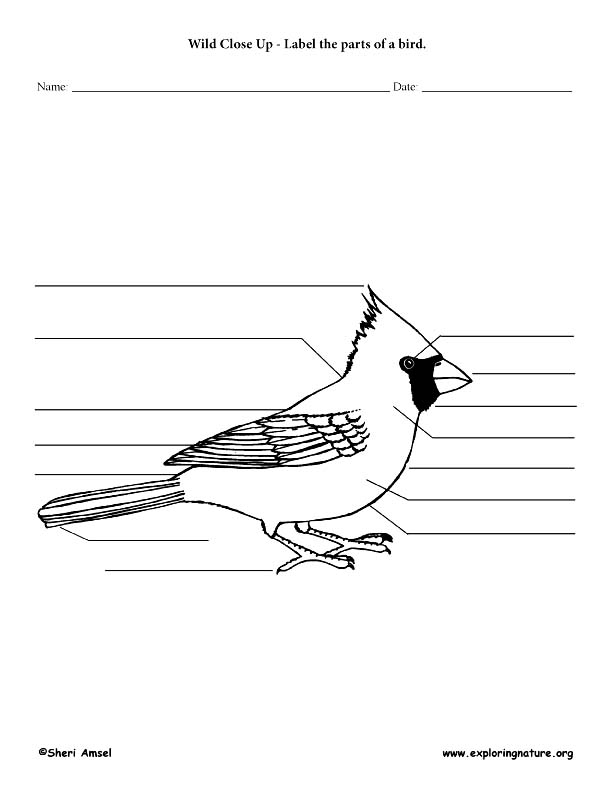

Birds are all around us whether we live in the city, suburbs, farm country or other rural areas. Because they are so common, they make great research subjects. This activity cross curicular lines to include reading about birds, drawing birds, learning facts about birds and studying birds using inquiry. First we will learn about birds.
There are many different groups or – Orders of birds. The Orders are grouped by the physical traits they share. Bird from different Orders, however, do share many traits and behaviors. What follows are some general facts about birds.
• Birds have feathers instead of hair or fur and are the only animal group that has feathers.
• Birds have a beak or bill instead of teeth. The beak shape and size varies with the diet of the bird.
• Birds have two feet, two wings.
• Birds are warm-blooded like mammals, but do not deliver live young. They lay eggs.
• Most birds take care of their young, feeding them until they are old enough to find their own food.
• Most birds build some kind of nest, though some lay eggs in “scrapes” on the ground or in the case of some penguins carry their egg on their feet under a warm belly flap.
• Birds have good eyesight and can see color.
• Most birds can fly. They are adapted for flight with hollow bones to make their skeleton lighter and large developed chest muscles. Flightless birds have other adaptations, like powerful leg muscles for running (ostriches) or fins for swimming (penguins).
• Birds can survive cold temperatures because they have an underlying layer of down feathers that act as thermal insulation (like wearing a down jacket).
• Male birds are often (but not always) more brightly colored than females. This is called sexual dimorphism. Their females are more dull-colored to blend in (camouflage) while nesting.
• Bird diets vary, with some birds eating meat (rodents, fish, other birds or carrion), some eating seeds and some eating plants.
• Many birds travel to a cooler climates for nesting and summer feeding and then return to warmer climates for the winter. Moving from place to place like this is called migration.
• Birds sing to attract a mate, mark a territory, sound an alarm at predators or to scare off intruders.
Here are some of the Orders of birds. This shows you how birds are grouped together.
Struthioniformes - Cassowaries, Emus, Kiwis, Ostriches and Rheas
Galliformes - Grouse, Quails, Pheasants and Turkeys
Anseriformes - Ducks, Geese, and Swans
Psittaciformes - Macaws and Parrots
Strigiformes - Owls
Trochiliformes - Hummingbirds
Coraciiformes - Kingfishers
Falconiformes - Hawks, Eagles, and Vultures
Gaviiformes - Loons
Piciformes - Woodpeckers
Charadriformes - Sandpipers and Seagulls
Ciconiiformes - Herons, Egrets, Storks, Bitterns, spoonbills and Penguins
Columbriformes - Doves and Pigeons
Passeriformes (songbirds) - Buntings, Cardinals, Catbirds, Chats, Chickadees, Crossbills, Crows, Dippers, Finches, Flycatchers, Goldfinches, Jays, Kinglets, Larks, Magpies, Martins, Mockingbirds, Nuthatches, Ovenbirds, Pipits, Robins, Ravens, Shrikes, Sparrows, Starlings, Swallows, Thrushes, Waxwings, Weavers, Woodcreepers, Woodwarblers, Wrens, Vireos, etc.
Find the downloadable high resolution pdf version at bottom.
When you research information you must cite the reference. Citing for websites is different from citing from books, magazines and periodicals. The style of citing shown here is from the MLA Style Citations (Modern Language Association).
When citing a WEBSITE the general format is as follows.
Author Last Name, First Name(s). "Title: Subtitle of Part of Web Page, if appropriate." Title: Subtitle: Section of Page if appropriate. Sponsoring/Publishing Agency, If Given. Additional significant descriptive information. Date of Electronic Publication or other Date, such as Last Updated. Day Month Year of access < URL >.
Amsel, Sheri. "Bird Inquiry - Read, Observe, Record" Exploring Nature Educational Resource ©2005-2024. December 14, 2024
< http://www.exploringnature.org/db/view/Bird-Inquiry-Read-Observe-Record >





